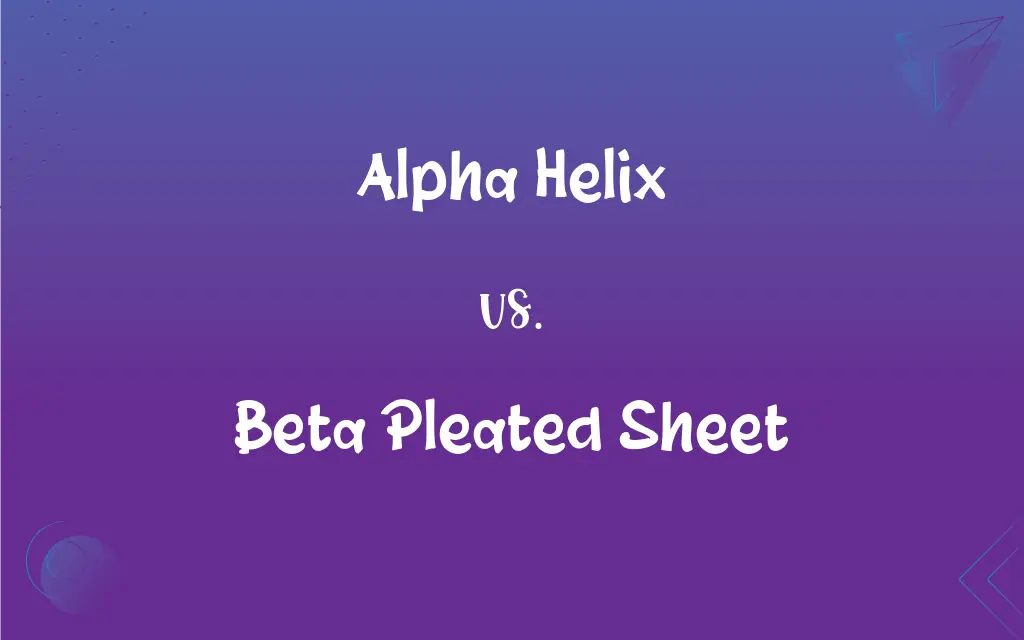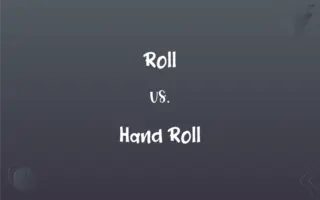Alpha Helix vs. Beta Pleated Sheet: What's the Difference?
Edited by Aimie Carlson || By Harlon Moss || Updated on October 9, 2023
Alpha helix and beta pleated sheet are secondary structures of proteins, differing in shape: an alpha helix is a spiral, while a beta pleated sheet is folded or pleated.

Key Differences
The alpha helix is a right-handed coiled strand, typically linked by hydrogen bonds. Beta pleated sheets, contrastingly, consist of beta strands connected laterally by at least two or three backbone hydrogen bonds, forming a generally planar structure. Thus, while both are foundational elements of protein structure, their configurations and hydrogen-bonding patterns significantly diverge.
Observably, the alpha helix appears as a spring-like structure, which is stabilized by hydrogen bonds between the carbonyl oxygen of one amino acid and the amide hydrogen of another. Beta pleated sheets can be parallel or antiparallel, depending on the directions of the polypeptide chains, and exhibit a flattened, pleated appearance due to their structure. Herein, the structural dynamics of these elements underscore the vast conformational heterogeneity in proteins.
Alpha helices are prevalent in various proteins, including keratin, contributing to fibrous, elongated structures. Beta pleated sheets, meanwhile, are foundational in many globular and fibrous proteins, including silk, where they offer structural stability. So, the influence of these two structures is vast, as they underpin the tertiary and quaternary formations and overall functionality of proteins.
On a molecular level, the alpha helix has 3.6 amino acids per turn, creating a compact and densely packed structure. On the flip side, beta pleated sheets, although flat, can be maneuvered into twisted and bent arrangements within the protein, providing both flexibility and stability. The discrepancy in the per-turn amino acid residue underscores the mechanistic diversity between them.
In terms of stability, the alpha helix’s hydrogen bonds are intra-chain, meaning they occur within the same polypeptide chain. In contrast, the beta pleated sheet can form hydrogen bonds between different polypeptide chains or between segments of the same chain that is folded back on itself. This characteristic distinction illustrates the subtle complexities that govern protein folding and stability.
ADVERTISEMENT
Comparison Chart
Shape
Spiral
Folded or pleated
Hydrogen Bonding Pattern
Intra-chain
Inter or intra-chain
Amino Acids per Turn
3.6
N/A
Commonly Found in
Keratin
Silk
Structural Orientation
Right-handed coil
Can be parallel or antiparallel
ADVERTISEMENT
Alpha Helix and Beta Pleated Sheet Definitions
Alpha Helix
The alpha helix has intra-chain hydrogen bonds stabilizing its form.
The alpha helix relies on hydrogen bonds between its own amino acid residues for stability.
Beta Pleated Sheet
Beta pleated sheet is a sheet-like secondary structure of proteins.
The beta pleated sheet is a characteristic structure in spider silk, providing it with strength and flexibility.
Alpha Helix
An alpha helix is a spiral-shaped secondary protein structure.
Keratin, found in hair and nails, primarily consists of alpha helices.
Beta Pleated Sheet
Beta pleated sheets can form within a single polypeptide or between different ones.
In certain proteins, a single polypeptide chain folds back on itself to form beta pleated sheets.
Alpha Helix
It possesses 3.6 amino acids per turn in its spiral structure.
The compact nature of the alpha helix is attributed to its 3.6 residues per turn.
Beta Pleated Sheet
Beta pleated sheets feature hydrogen bonds between adjacent strands.
The planar, stable formation of a beta pleated sheet is due to inter-strand hydrogen bonding.
Alpha Helix
The alpha helix is a right-handed coil.
When observing a protein, the right-handed coiling of an alpha helix is distinctly visible.
Beta Pleated Sheet
It presents a flat, pleated form in protein structures.
The beta pleated sheet, with its flattened configuration, contributes to the structural framework of many proteins.
Alpha Helix
Alpha helices are predominant in fibrous proteins like keratin.
The sturdiness of keratin fibers is significantly attributed to the alpha helix structure.
Beta Pleated Sheet
It can exist in parallel or antiparallel configurations.
The beta pleated sheets in silk are typically antiparallel, enhancing their stability.
FAQs
Are alpha helices found in fibrous proteins?
Yes, alpha helices are a predominant structure in some fibrous proteins, such as keratin.
What is an alpha helix in proteins?
The alpha helix is a spiral, coiled secondary structure in proteins, stabilized by intra-chain hydrogen bonds.
Is the beta pleated sheet structure common in silk?
Yes, beta pleated sheets, particularly in antiparallel configuration, are a key structural feature in silk.
Can beta pleated sheets form between different polypeptide chains?
Yes, beta pleated sheets can form hydrogen bonds between different polypeptide chains or within the same chain.
Can a single protein contain both alpha helices and beta pleated sheets?
Yes, many proteins feature a combination of alpha helices and beta pleated sheets.
Are the alpha helix and beta pleated sheet the only secondary structures in proteins?
While prominent, they are not the only secondary structures, but they are among the most well-studied and common.
Does the alpha helix exhibit a right- or left-handed coil?
The alpha helix typically forms a right-handed coil.
Which secondary structure is more compact, the alpha helix or beta pleated sheet?
The alpha helix is generally more compact due to its coiled nature and 3.6 amino acids per turn.
Can a protein’s function be deduced from its alpha helices and beta pleated sheets?
Not conclusively, but their arrangement provides insights into stability, shape, and potential functions of the protein.
What characterizes beta pleated sheets?
Beta pleated sheets are sheet-like secondary protein structures, stabilized by hydrogen bonds between adjacent strands.
What contributes to the stability of the alpha helix?
The stability of the alpha helix is due to hydrogen bonds between the carbonyl oxygen and amide hydrogen of amino acids within the same chain.
What is the amino acid per turn ratio in an alpha helix?
An alpha helix typically has 3.6 amino acids per turn.
What determines whether a beta pleated sheet is parallel or antiparallel?
The directional orientation of the polypeptide chains determines whether a beta pleated sheet is parallel or antiparallel.
How does the alpha helix differ from the beta pleated sheet?
Alpha helices are spiral structures with intra-chain hydrogen bonds, while beta pleated sheets are flat structures with inter- or intra-chain hydrogen bonds.
What types of beta pleated sheet configurations exist?
Beta pleated sheets can exist in parallel or antiparallel configurations.
Do alpha helices and beta pleated sheets have a role in determining protein function?
Yes, their structural characteristics and arrangement significantly influence the overall shape and function of proteins.
How does hydrogen bonding in beta pleated sheets work?
Hydrogen bonds form between the carbonyl oxygen of one strand and the amide hydrogen of an adjacent strand, either within the same chain or between different chains.
Are beta pleated sheets always flat and straight?
While they are sheet-like, beta pleated sheets can bend and twist within proteins.
Is the alpha helix generally soluble in water?
Yes, proteins with alpha helices often exhibit solubility in water, especially if their exterior residues are hydrophilic.
How are alpha helices and beta pleated sheets detected in protein structures?
Techniques like X-ray crystallography and nuclear magnetic resonance (NMR) spectroscopy can identify these structures.
About Author
Written by
Harlon MossHarlon is a seasoned quality moderator and accomplished content writer for Difference Wiki. An alumnus of the prestigious University of California, he earned his degree in Computer Science. Leveraging his academic background, Harlon brings a meticulous and informed perspective to his work, ensuring content accuracy and excellence.
Edited by
Aimie CarlsonAimie Carlson, holding a master's degree in English literature, is a fervent English language enthusiast. She lends her writing talents to Difference Wiki, a prominent website that specializes in comparisons, offering readers insightful analyses that both captivate and inform.
































































